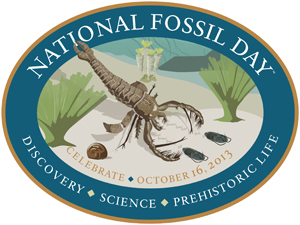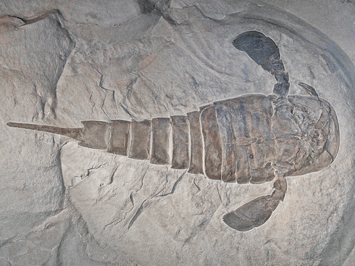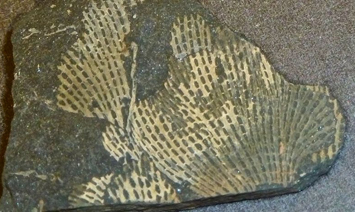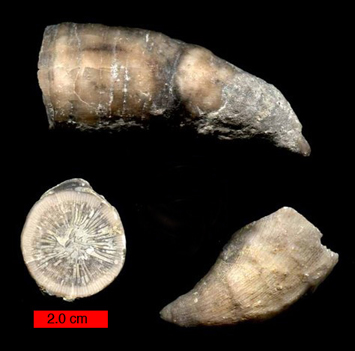Paleozoic Life

The 2013 National Fossil Day artwork features a variety of marine invertebrates from the Paleozoic Era. The scene is an idealized representation of a seafloor from the Ordovician Period (between about 485 and 444 million years ago) near what is now Cincinnati, Ohio.
Along the seafloor, a eurypterid, also known as a sea scorpion, chases after a soon-to-be meal of trilobites. Bryozoan fronds and rugose, or horn, corals are present in the background. A gastropod (snail) is partially buried in the sand of the seafloor.
Eurypterids

Photo by H. Zell (CC BY-SA 3.0).
Eurypterids were fearsome predators of Paleozoic seas across the globe. They were also among the largest arthropods (same phylum as insects, spiders, and crustaceans), getting up to more than eight feet in length. Early forms were marine, later eurypterids lived in brackish or even fresh water. There are about 250 species of eurypterids, all of them are now extinct. They range in age from the Ordovician to the Permian but are most diverse in rocks of the Silurian and Devonian (see a time scale). In North America they are found primarily in New York, Pennsylvania, Indiana, Illinois, and Ohio. The eurypterid in the logo is based on the Ordovician genus Megalograptus.
Eurpyterids, sometimes called "sea scorpions," have a fittingly predatory appearance. The front set of appendages are chelicerae that look like (but are not homologous to) scorpion pincers. Behind the chelicerae are legs. The last pair of appendages are paddles (modified legs) for swimming. At the end of the segmented body is a telson that can be a spike, a paddle, or set of pincers. Although the telson looks similar to a scorpion's stinger, it is unlikely that eurypertids could sting. Nevertheless, you probably wouldn't want to tangle with one that was longer than you are tall! Eurypterids probably ate, or scavenged, just about anything they could catch or fit in their mouth. The trilobites shown in the logo may have been a common meal.
Word Origins
The name eurypterid is derived from the Greek word for "wide" or "broad" (eurys) and the Greek word for "wing" (pteryx). "Wide or broad wing" refers to the wide swimming paddles.
Eurypterid Fossil Facts
- Eurypterids were fearsome aquatic predators of the Paleozoic. The 2011 National Fossil Day artwork featured a fearsome aquatic predator of the Mesozoic.
- Eurypterids were the largest arthropods, attaining sizes more than 8 feet long!
- They lived from about 460 to 270 million years ago (during the Ordovician through Permian). Eurypterids are now extinct.
- The state fossil of New York is a Silurian eurypterid: Eurypterus remipes (the first eurypterid ever discovered).
Trilobites

Virtual Fossil Museum photo, http://www.fossilmuseum.net
Trilobites were a spectacularly diverse group of marine invertebrates and the most well-known Paleozoic fossil. Fossils of more than 17,000 species have been discovered on every continent. Trilobites were almost exclusively benthic, meaning they lived on the seafloor. They fed on detritus, organic material that settled to the bottom, using their many legs to "kick" food particles toward their mouth. With thousands of species, trilobites attained many different sizes, from slightly bigger than microscopic to more than two feet long. They also had a wondrous array of ornamentation, from unadorned to covered in spikes and spines. View a sample here or here. The trilobite in the logo was based on the Ordovician genus Isotelus.
Trilobites are among the oldest Paleozoic marine invertebrates, appearing about 540 million years ago during the Cambrian. By the end of the Cambrian, about 50 million years later, they achieved their maximum diversity. Afterwards, they dwindled in diversity but not necessarily abundance during the rest of Paleozoic. The last few trilobite lineages were extinct by the end of the Paleozoic Era, 251 million years ago. All told, trilobites scuttled along the floors of Earth's oceans for around 290 million years. By comparison, dinosaurs lived for about half that amount of time and the human genus Homo has been around for not quite one percent of that span.
Word Origins
The term "trilobite" was derived from Greek words meaning "three-lobed" referring to the three longitudinal (parallel to the body's length) lobes of trilobites.
Trilobite Fossil Facts
- Trilobites were incredibly diverse marine arthropods which primarily lived on the seafloor and fed on detritus.
- Trilobites are now extinct, although they existed throughout the Paleozoic and their fossils are found on every continent.
- Some trilobites could roll up into a tight "ball" to protect their vulnerable soft parts.
Three states have trilobites as their official state fossil:
- Ohio (Isotelus) from the Ordovician
- Pennsylvania (Phacops rana) from the Devonian
- Wisconsin (Calymene celebra) from the Ordovician and Siluiran.
Bryozoans

NPS photo by Rebecca Port.
Bryozoans appear similar to coral and are primarily sessile (immobile), colonial marine animals. However, bryozoans are in a completely different phylum than corals, and the bryozoans were among the last animal phyla to appear in the fossil record. Definitive bryozoan fossils appear in the Ordovician, although some recent discoveries may push their first appearance in the fossil record back to the upper Cambrian. Bryozoans (also called "ectoprocts") are still extant, with about 5000 living species today. There are a few times that number known from the fossil record.
Individual bryozoans, rarely more than a millimeter across, are called "zooids." They live in colonies ranging from a few to a few million zooids. Bryozoans feed on even smaller microorganisms like diatoms via a filter-feeding structure called a "lophophore." They secrete a rigid skeleton of calcium carbonate (limestone) that forms the framework for the colony. The colonies can encrust (hence their name) hard surfaces or form expansive frond-like structures. Upright frond-like colonies, such as those on the National Fossil Day artwork, were common during the Paleozoic. The bryozoans in the logo were based on the Ordovician and Silurian genus Chasmatopora.
Word Origins
The term bryozoan is derived from the Greek words for moss (bryon) and animal (zoös). "Moss animal" is a common name for bryozoans and refers to the moss-like appearance of encrusting species.
Bryozoan Fossil Facts
- Bryozoans, or "moss animals", are sessile, colonial, marine animals that superficially resemble corals, but are from a completely different phylum.
- They are one of the latest-appearing phyla in the fossil record and are still extant today.
- Fossils are found on every continent and across North America.
- Bryozoan colonies encrust hard surfaces (even the bottoms of ships!) or form beautiful fronds.
Rugose Corals

Public domain, wikipedia.org
Rugose corals, also called "horn corals," are an extinct group of Paleozoic corals that were abundant from the Middle Ordovician through the Late Permian. They reached their peak diversity during the Devonian and their fossils have been found on every continent except Antarctica. They are found across North America but are particularly common in New England and the Ohio River valley. Individual rugose coral polyps were stationary and constructed calcium carbonate (limestone) frameworks. Some rugosans were solitary while others formed colonies.
Solitary rugosans often were horn-shaped, giving the group its common name, and could reach sizes around three feet in length. Although none of their soft parts have been preserved, rugose coral polyps were likely similar to modern corals in that they had tentacles (perhaps even with stinging cells) and could capture food floating past. You could call them "microcarnivores"!
Word Origins
Rugosus is Latin for "wrinkled" or "shriveled," referring to the wall of the coral.
Rugose Coral Fossil Facts
- Rugose corals were abundant corals during the Middle Ordovician through the Late Permian. They are now extinct.
- Solitary rugosans are called "horn corals" and some were around 3 feet long.
- Although they look like modern corals, rugosans are a much more ancient group, going extinct before modern stony corals appear in the fossil record.
- No rugosan corals are state fossils, but other Paleozoic corals have been selected as the state rock of Michigan (Hexagonaria percarinata, the "Petoskey Stone," of Devonian age) and the state stone of West Virginia (Lithostrotionella, of Mississippian age).
Go See Them!
Numerous National Fossil Day partner fossil sites and museums are excellent places to learn about the fossils on the 2013 artwork. For example, the first discovered eurypterid fossil (the state fossil of New York) and the largest complete eurypterid fossil are both at the Paleontological Research Institution's Museum of the Earth. Trilobites are featured on the logos of many NFD partners. You can see bryozoans and rugose corals at Falls of the Ohio State Park (Indiana). A variety of Paleozoic invertebrates can be discovered at Mineral Wells Fossil Park (Texas).
Overall, Paleozoic marine invertebrates are incredibly common fossils and can be found in just about every natural history museum and rock shop in the country. You can also see them in many building stones. For example, the Indiana Limestone is a popular building stone (see it on the National Mall and the Empire State Building) nationwide that is chock full of fossils. Rock outcrops of Paleozoic limestone are commonly fossiliferous.
Learn more about National Fossil Day and the NFD Logos and Artwork on the official National Fossil Day website.
Part of a series of articles titled National Fossil Day Logo and Artwork – Prehistoric Life Illustrated.
Last updated: September 4, 2020
